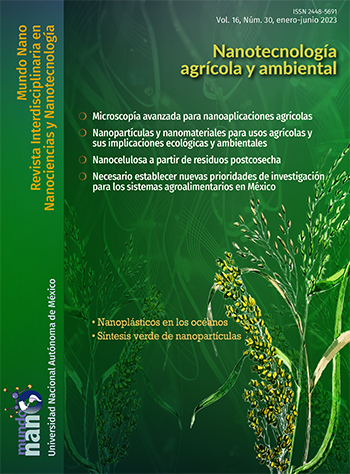Manejo de la cascarilla de arroz como residuo postcosecha y su conversión en nanocelulosa
Contenido principal del artículo
Resumen
La falta de conciencia ambiental de los productores agrícolas y las pobres políticas gubernamentales para el manejo de residuos es uno de los retos que enfrenta la agroindustria. La producción de nanobiocompuestos ha sido reconocida recientemente con la obtención de celulosa. Este trabajo tiene como objetivo la obtención y caracterización de nanocelulosa a partir de cascarilla del arroz (Oryza sativa L.) Var. “Morelos A-2010”, considerada como residuo contaminante producida en el estado de Morelos. La cascarilla de arroz fue tamizada, procesada mediante extracción alcalina, blanqueada y procesada por un pretratamiento ácido. A la celulosa obtenida se le realizo una hidrólisis ácida (H2SO4) y un tratamiento de sonicación para producir nanocelulosa. Al final, las muestras fueron procesadas por (FTIR), (DSC) y visualización morfológica, mediante (SEM). Se obtuvieron rendimientos de 29 a 41% de celulosa, con posterior conversión en nanocelulosa con cristales de 86 a 173 nm, concluyendo así, que este residuo puede tener un manejo sostenible y convertirse en un producto reciclable de alto potencial.
Descargas
Detalles del artículo

Mundo Nano. Revista Interdisciplinaria en Nanociencias y Nanotecnología, editada por la Universidad Nacional Autónoma de México, se distribuye bajo una Licencia Creative Commons Atribución-NoComercial 4.0 Internacional.
Basada en una obra en http://www.mundonano.unam.mx.
Citas
Abe, K., Iwamoto, Sh. y Yano K. H. (2007). Obtaining cellulose nanofibers with a uniform width of 15 nm from wood. Biomacromolecules, 8(10): 3276-3278. https://doi.org/10.1021/bm700624p DOI: https://doi.org/10.1021/bm700624p
An, V. N., Chi N. H., Tap T. T. D, Tran D. V., Thanh T.T., Pham V. V., Le V. H. (2020). Extraction of high crystalline nanocellulose from biorenewable sources of vietnamese agricultural wastes. J. Polym Environ, 28: 1465-1474. https://doi.org/10.1007/s10924-020-01695-x DOI: https://doi.org/10.1007/s10924-020-01695-x
Araki J., Wada, M., Kuga Sh. y Okano T. (2000). Birefringent glassy phase of a cellulose microcrystal suspension. Langmuir, 16(6): 2413-2415. https://doi.org/10.1021/la9911180 DOI: https://doi.org/10.1021/la9911180
Álvarez-Hernández, J. C., Tapia-Vargas L. M., Hernández-Pérez A., Barrios-Gómez E. J. y Pardo-Melgarejo S. (2018). Estabilidad productiva de líneas avanzadas de arroz grano largo delgado en Michoacán, México. Revista mexicana de ciencias agrícolas. Rev. Mexicana Cienc. Agric., 9: 629-637. https://doi.org/10.29312/remexca.v9i3.606 DOI: https://doi.org/10.29312/remexca.v9i3.606
Bano, S., y Negi. Y. S. (2017). Studies on cellulose nanocrystals isolated from groundnut shells. Carbohydr. Polym., 157: 1041-1049. https://doi.org/10.1016/j.carbpol.2016.10.069 DOI: https://doi.org/10.1016/j.carbpol.2016.10.069
Battegazzore, D., Bocchini, S., Alongi, J., Frache, A., Marino, F. (2014). Cellulose extracted from rice husk as filler for poly(lactic acid): preparation and characterization. Cellulose, 2: 1813-1821. https://doi.org/10.1007/s10570-014-0207-5 DOI: https://doi.org/10.1007/s10570-014-0207-5
Bhardwaj, U., Dhar, P., Kumar, A., Katiyar, V. (2014). Polyhydroxyalkanoates (PHA)-cellulose based nanobiocomposites for food packaging. J. Am. Chem. Soc., cap. 19. 1162, 10. 275-314. https://pubs.acs.org/doi/full/10.1021/bk-2014-1162.ch019 DOI: https://doi.org/10.1021/bk-2014-1162.ch019
Chakraborty, A., Sain, M. y Kortschot, M. (2005). Cellulose microfibrils: A novel method of preparation using high shear refining and cryocrushing. Holzforschung, 59: 102-107 https://doi.org/10.1515/HF.2005.016 DOI: https://doi.org/10.1515/HF.2005.016
Chandrasekhar, S., Satyanarayana, K. G., Pramada, P. N., Raghavan, P. y Gupta T. N. (2003). Cellulose microfibrils: A novel method of preparation using high shear refining and cryocrushing. J. Mater. Sci., 38: 3159-3168. https://link.springer.com/article/10.1023/A:1025157114800 DOI: https://doi.org/10.1023/A:1025157114800
De Oliveira, J. P., Pinheiro, G. B., Oliveira, K .L., Mello, S. L., Halal El., Silveira da Rosa G., Guerra Dias, A. R., Da Rosa Zavareze, El. (2017). Food Chemistry, 221: 153-160. https://doi.org/10.1016/j.foodchem.2016.10.048 DOI: https://doi.org/10.1016/j.foodchem.2016.10.048
Ditzel, F. I., Prestes, E., Carvalho, B. M., Demiate, I. M., Pinheiro, L. A. (2017). Nanocrystalline cellulose extracted from pine wood and corncob. Carbohydr. Polym., 157: 1577-1585. https://doi.org/10.1016/j.carbpol.2016.11.036 DOI: https://doi.org/10.1016/j.carbpol.2016.11.036
Flauzino, N. W. P., Alves, S. V., Oliveira, D. N., Pasquini, D. (2013). Extraction and characterization of cellulose nanocrystals from agro-industrial residue – Soy hulls. Industrial Crops and Products, 42(1): 480-488. https://doi.org/10.1016/j.indcrop.2012.06.041 DOI: https://doi.org/10.1016/j.indcrop.2012.06.041
Frenot, A., Henriksson, M. W. y Walkenström, P. (2007). Electrospinning of cellulose-based nanofibers. J Appl Polym Sci., 103: 1473-1482. https://doi.org/10.1002/app.24912 DOI: https://doi.org/10.1002/app.24912
Halal, S. L. M., Colussi, R., Deon, V. G., Pinto, V. Z., Villanova, F. A. y Carreño N. L. V. (2015). Films based on oxidized starch and cellulose from barley. Carbohydr. Polym., 133: 644-653. https://doi.org/10.1016/j.carbpol.2015.07.024 DOI: https://doi.org/10.1016/j.carbpol.2015.07.024
Hayashi, N., Kondo, T. y Ishihara, M. (2005). Enzymatically produced nano-ordered short elements containing cellulose Iβ crystalline domains. Carbohydr. Polym., 61: 191-197. https://doi.org/10.1016/j.carbpol.2005.04.018 DOI: https://doi.org/10.1016/j.carbpol.2005.04.018
Henriksson, M. W., Henriksson, G., Berglund, L. A. y Lindström, T. (2007). An environmentally friendly method for enzyme-assisted preparation of microfibrillated cellulose (MFC) nanofibers. Europ. Polymer J., 43: 3434-3441. https://doi.org/10.1016/j.eurpolymj.2007.05.038 DOI: https://doi.org/10.1016/j.eurpolymj.2007.05.038
Hossain, M. I., Zaman, H. y Rahman, T. (2018). Derivation of nanocellulose from native rice husk. Chem. Eng. Res. Bull., 20: 19-22. https://doi.org/10.3329/cerb.v20i1.36926 DOI: https://doi.org/10.3329/cerb.v20i1.36926
Iwamoto, S., Kai, W., Isogai, T., Saito, T., Isogai, A. y Iwata, T. (2010). Comparison study of TEMPO-analogous compounds on oxidation efficiency of wood cellulose for preparation of cellulose nanofibrils. Polym Degrad Stab., 95: 1394-1398. https://doi.org/10.1016/j.polymdegradstab.2010.01.017 DOI: https://doi.org/10.1016/j.polymdegradstab.2010.01.017
Jiang, L., Morelius, E., Zhang, J., Wolcott, M., Holbery, J. (2008). Study of the poly (3-hydroxybutyrate-co-3-hydroxyvalerate)/cellulose nanowhisker composites prepared by solution casting y melt processing. J. Compos Mater., 42: 2629-2645. https://doi.org/10.1177%2F0021998308096327 DOI: https://doi.org/10.1177/0021998308096327
Johar, N., Ahmad, I., Dufresne, A. (2012). Extraction, preparation y characterization of cellulose fibres y nanocrystals from rice husk. Ind. Crops Prod., 37: 93-99. https://doi.org/10.1016/j.indcrop.2011.12.016 DOI: https://doi.org/10.1016/j.indcrop.2011.12.016
Kargarzadeh, H., Ahmad, I., Thomas, S. y Dufresne, A. (2017). E. Book. Handbook of nanocellulose and cellulose nanocomposites. ISBN: 978-3-527-33866-5. 2, 920. https://application.wiley-vch.de/books/sample/3527338667_c01.pdf DOI: https://doi.org/10.1002/9783527689972
Kaur, M., Kumari, S., y Sharma P. (2018). Chemically modified nanocellulose from rice husk: synthesis and characterization. Advances in Research., 13(3): 1-11. https://doi.org/10.9734/AIR/2018/38934 DOI: https://doi.org/10.9734/AIR/2018/38934
Khan, M. N., Rehman, N., Sharif, A., Ahmed, E., Farooqi, Z. H. y Din, M. I. (2020). Environmentally benign extraction of cellulose from dunchi fiber for nanocellulose fabrication. Int. J. Biol. Macromol., 153: 72–78. https://doi.org/10.1016/j.ijbiomac.2020.02.333 DOI: https://doi.org/10.1016/j.ijbiomac.2020.02.333
Leite, A. L. M., Zanon, C. D., Menegalli, F. C. (2017). Isolation and characterization of cellulose nanofibers from cassava root bagasse and peelings. Carbohydr. Polym., 157: 962-970. https://doi.org/10.1016/j.carbpol.2016.10.048 DOI: https://doi.org/10.1016/j.carbpol.2016.10.048
Liu, H., Liu, D., Yao, F. y Wu, Q. (2010). Fabrication and properties of transparent polymethyl methacrylate/cellulose nanocrystals composites. Bioresour. Technol., 101: 5685-5692. https://doi.org/10.1016/j.biortech.2010.02.045 DOI: https://doi.org/10.1016/j.biortech.2010.02.045
Ludueña, L., Fasce, D., Alvarez, V. A. y Stefani, I. P. M. (2011). Nanocellulose from rice husk following alkaline treatment to remove silica. BioResources., 6: 1440-1453. https://bioresources.cnr.ncsu.edu/resources/nanocellulose-from-rice-husk-following-alkaline-treatment-to-remove-silica/ DOI: https://doi.org/10.15376/biores.6.2.1440-1453
Maiti, S., Jayaramudu, J., Das, K., Reddy, S. M., Sadiku, R., Ray, S. S., Liu, D. (2013). Preparation and characterization of nano-cellulose with new shape from different precursor. Carbohydr Polym., 98: 562-567. https://doi.org/10.1016/j.carbpol.2013.06.029 DOI: https://doi.org/10.1016/j.carbpol.2013.06.029
Maleki, A., Movahed, H., Ravaghi, P. (2017). Magnetic cellulose/Ag as a novel eco-friendly nanobiocomposite to catalyze synthesis of chromene-linked nicotinonitriles. Carbohydr. Polym., 156: 259-267. https://doi.org/10.1016/j.carbpol.2016.09.002 DOI: https://doi.org/10.1016/j.carbpol.2016.09.002
Mandal, A. y Chakrabarty, D. (2011). Isolation of nanocellulose from waste sugarcane bagasse (SCB) and its characterization. Carbohydr. Polym., 86(3): 1291-1299 https://doi.org/10.1016/j.carbpol.2011.06.030 DOI: https://doi.org/10.1016/j.carbpol.2011.06.030
Morán, J. I., Alvarez, V. A., Cyras, V. A. y Vázquez, A. (2008). Extraction of cellulose and preparation of nanocellulose from sisal fibers. Cellulose, 15: 149-159. http://pubs.sciepub.com/nnr/4/1/2/index.html DOI: https://doi.org/10.1007/s10570-007-9145-9
Naduparambath, S., Jinitha, T. V., Shaniba, V., Sreejith, M. P., Balan, A. K. (2018). Solation and characterization of cellulose nanocrystals from sago seed shells. Carbohydr Polym., 15(180): 13-20. https://doi.org/10.1016/j.carbpol.2017.09.088 DOI: https://doi.org/10.1016/j.carbpol.2017.09.088
Nakagaito, A. N. y Yano, H. (2004). The effect of morphological changes from pulp fiber towards nano-scale fibrillated cellulose on the mechanical properties of high-strength plant fiber-based composites. Applied Physics A., 78: 547-552. https://doi.org/10.1007/s00339-003-2453-5 DOI: https://doi.org/10.1007/s00339-003-2453-5
Onoja, D. A., Ahemen, I., Iorfa, T. F. (2019). Synthesis and characterization of cellulose based nanofibres from rice husk. J Appl Phys., 11: 80-87. https://www.iosrjournals.org/iosr-jap/papers/Vol11-issue2/Series-3/G1102038087.pdf
Peñaranda, L. V., Abad, G. P., Montenegro, G. S. P. y Giraldo, A. P. (2017). Aprovechamiento de residuos agroindustriales en Colombia. Rev. Investig. Agrar. Ambient., 8: 141-150 https://hemeroteca.unad.edu.co/index.php/riaa/article/view/2040 DOI: https://doi.org/10.22490/21456453.2040
Phanthong, P., Reubroycharoen, P., Hao, X., Xu, G., Abudula, A. Y Guan, G. (2018). Nanocellulose: extraction and application. Carbon Resour. Conversa., 1: 32-43. https://doi.org/10.1016/j.crcon.2018.05.004 DOI: https://doi.org/10.1016/j.crcon.2018.05.004
Rachtanapun, P., Luangkami, S., Tanprasert, K. y Suriyatem, R. (2012). Carboxymethyl cellulose film from durian rind. Food Sci Technol., 48: 52-58. https://doi.org/10.1016/j.lwt.2012.02.029 DOI: https://doi.org/10.1016/j.lwt.2012.02.029
Rashid, S. Y Dutta, H. (2020). Characterization of nanocellulose extracted from short, medium and long grain rice husks. Ind. Crops Prod., 154: 112627. https://doi.org/10.1016/j.indcrop.2020.112627 DOI: https://doi.org/10.1016/j.indcrop.2020.112627
Rezanezhad, S., Nazanezhad, N. y Asadpur, G. (2013). Isolation of nanocellulose from rice waste via ultrasonication. Lignocellulose, 2: 282-291. http://lignocellulose.sbu.ac.ir/Issue%2004/Ligno74_Rezanezhad_2013_Nanocellulose%20from%20Rice%20Waste_282_291_MAH_FDV.pdf
Rosa, S. M. L., Rehman, N., de Miranda, M. I., Nachtigal, S. M. B. y Bica, C. I. D. (2012). Chlorine-free extraction of cellulose from rice husk and whisker isolation. Carbohydr. Polym., 87(2): 1131-1138. https://doi.org/10.1016/j.carbpol.2011.08.084 DOI: https://doi.org/10.1016/j.carbpol.2011.08.084
Saito, T., Hirota, M., Tamura, N., Kimura, S., Fukuzumi, H., Heux, L. y Isogai, A. (2009). Individualization of nano-sized plant cellulose fibrils by direct surface carboxylation using TEMPO catalyst under neutral conditions. Biomacromolecules, 10: 1992-1996. https://doi.org/10.1021/bm900414t DOI: https://doi.org/10.1021/bm900414t
Salcedo, A. J., Barrios, G. E. J., Salcedo, A. J. y Barrios, G. E. J. (2012). Morelos A-2010, nueva variedad de arroz para siembra directa para el Centro de México. Rev. Mexicana Cienc. Agric., 7: 1453-1458. http://www.scielo.org.mx/pdf/remexca/v3n7/v3n7a15.pdf DOI: https://doi.org/10.29312/remexca.v3i7.1352
Santos, L. J. J. y Silva, A. C. A. (2019). Obtención de nanocelulosa a partir de la cascarilla de arroz mediante hidrólisis ácida, tesis doctoral, Universidad de Guayaquil, Facultad de Ingeniería Química. http://repositorio.ug.edu.ec/bitstream/redug/40057/1/401-1370%2020obtenc%20nanocelulosa%20a%20partir%20cascarilla%20arroz%20mediante%20hidr%C3%B3lisis%20%C3%A1cida.pdf
Satyanarayana, K. G., Arizaga, G. G. C. y Wypych, F. (2009). Biodegradable composites based on lignocellulosic fibers-An overview. Prog Polym Sci., 34: 982-1021. http://dx.doi.org/10.1016/j.progpolymsci.2008.12.002 DOI: https://doi.org/10.1016/j.progpolymsci.2008.12.002
Sinha, S. y Singh, J. (2020). Effective technologies and lifestyle changes to reuse and control waste generation from natural and anthropogenic activities for sustainable future. Int. Res. J. Environmental Sci., 9: 51-61.
Soares, S., Camino, G., Levchik, S. (1995). Comparative study of the thermal decomposition of pure cellulose and pulp paper. Polym Degrad Stab., 49: 275-283. https://doi.org/10.1016/0141-3910(95)87009-1 DOI: https://doi.org/10.1016/0141-3910(95)87009-1
Tang, Y., Shen, X., Zhang, J., Guo, D., Kong, F., Zhang, N., (2015). Extraction of cellulose nano-crystals from old corrugated container fiber using phosphoric acid and enzymatic hydrolysis followed by sonication. Carbohydr. Polym., 125: 360-366. https://doi.org/10.1016/j.carbpol.2015.02.063 DOI: https://doi.org/10.1016/j.carbpol.2015.02.063
Tong, K. T., Vinai, R., Soutsos, M. N. (2018). Use of Vietnamese rice husk ash for the production of sodium silicate as the activator for alkali-activated binders. J. Clean Prod., 201: 272-286. https://doi.org/10.1016/j.jclepro.2018.08.025 DOI: https://doi.org/10.1016/j.jclepro.2018.08.025
Vargas, J., Alvarado, P., Vega-Baudrit., J., Porras M. (2013). Caracterización del subproducto cascarillas de arroz en búsqueda de posibles aplicaciones como materia prima en procesos. Rev. Científica. Universidad de Costa Rica, Laboratorio de Polímeros, 23(1): 86-101. https://dialnet.unirioja.es/servlet/articulo?codigo=5069938 DOI: https://doi.org/10.54495/Rev.Cientifica.v23i1.115
Wang, Z., Yao, Z., Zhou, J., Zhang, Y. (2017). Reuse of waste cotton cloth for the extraction of cellulose nanocrystals. Carbohydr Polym., 157: 945-952. https://doi.org/10.1016/j.carbpol.2016.10.044 DOI: https://doi.org/10.1016/j.carbpol.2016.10.044
Zhang, K., Sun, P., Liu, H., Shang, S., Song, J., Wang, D. (2016). Extraction and comparison of carboxylated cellulose nanocrystals from bleached sugarcane bagasse pulp using two different oxidation methods. Carbohydr. Polym., 138: 237-243. https://doi.org/10.1016/j.carbpol.2015.11.038 DOI: https://doi.org/10.1016/j.carbpol.2015.11.038
Zhou, Y., Fuentes-Hernández, C., Khan, T. M., Liu, J. C., Hsu, J., Shim, J. W., Dindar, A., Youngblood, J. P., Moon, R. J., Kippelen, B. (2013). Recyclable organic solar cells on cellulose nanocrystal substrates. Sci Rep., 3: 1536. https://doi.org/10.1038/srep01536 DOI: https://doi.org/10.1038/srep01536





